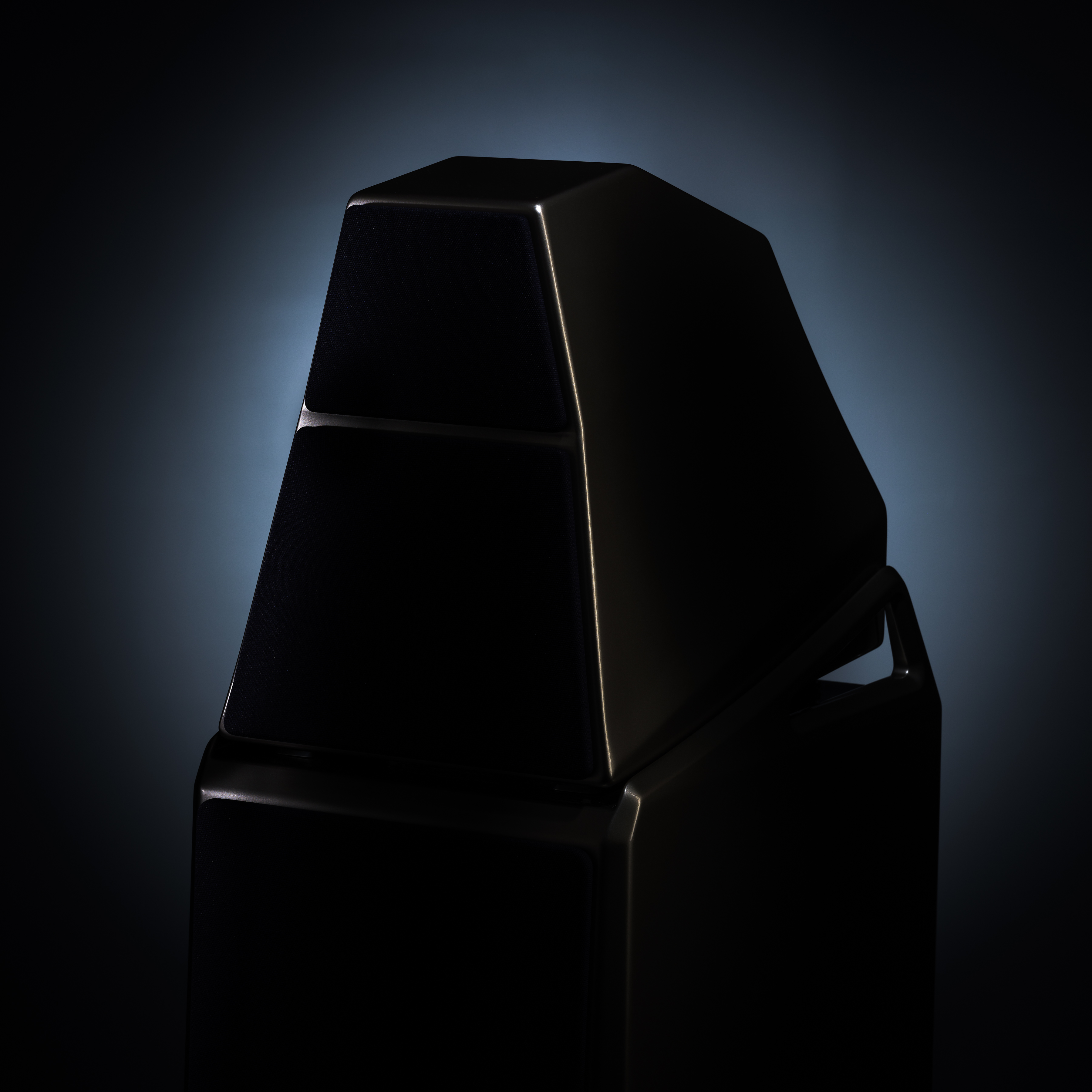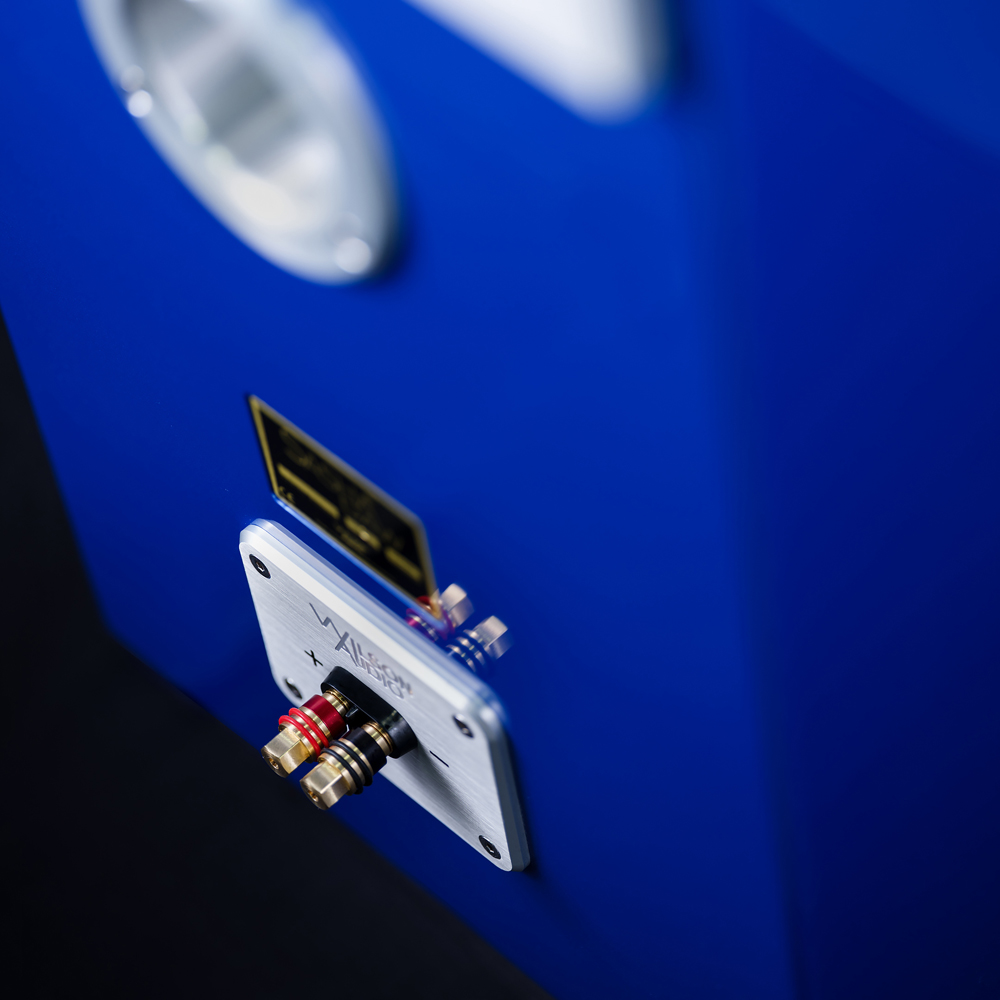


Technical Specs
Drivers
Enclosure Types:
Enclosure Type Upper Module:
Rear Vented Midrange, X&S-Material
Enclosure Type Woofer Module:
Rear Ported Woofer, X-Material
Drivers:
Woofers:
Two – 8 inch (20.32 cm)
Midrange:
One – 7 inch (17.78 cm)
Tweeter:
One – 1 inch, Dome (2.54 cm)
Measurements
Sensitivity:
91 dB (one watt at one meter at 1kHz)
Nominal Impedance:
4 ohms / minimum 2.48 ohms @ 85 Hz
Minimum Amplifier Power:
25 watts per channel
Frequency Response:
20 Hz –30 kHz +/- 3 dB
room average response [RAR]
Overall Dimensions
Height:
44 3/4 inches (113.67 cm)
Width:
14 1/2 inches (36.83 cm)
Depth:
22 15/16inches (58.26 cm)
Overall Weight
Weight Per Channel
236 lbs (107.05 kg)
System Shipping Weight (approx):
710 lbs (322.05 kg)
An All-New Sasha
Daryl decided a fresh look at the Sasha was in order. He approached the Sasha as if it were an all-new loudspeaker, taking the elements that very clearly worked in its design and, at the same time, applying the myriad technologies generated by Wilson’s design team since the advent of the Series 2 nearly five years ago. The result is the largest upgrade in the history of the WATT/Puppy and Sasha platforms.
In recognition for the man who started it all, the Wilson team felt it apropos to dedicate this most ambitious iteration of the Wilson compact loudspeaker in its history to the visionary who first imagined it thirty years ago. Introducing the Sasha DAW. DAW for David Andrew Wilson, an homage to the man who started it all.
The Man Who Started it All
The original WATT began not as a response to a perceived market need. It was not the product of focus groups. Dave Wilson never intended it to be a commercial product at all.
Dave designed the WATT in 1985 as a tool for himself. He was a recording engineer who needed a loudspeaker he could take with him to on-location recording venues, a location monitor that spoke the same language as his revolutionary and revered WAMM reference monitor, a precision tool that aided him in his efforts to make recordings that sounded indistinguishable from the unamplified live event.
In other words, Dave was literally designing the loudspeaker he wanted to own. There was a certain freedom this approach afforded Dave. He was not governed by business-school notions of market need. He was not hamstrung by considerations of an acceptable price point or perceived value. Without these considerations, he was unrestricted to design and build a loudspeaker that specifically fit his desire for a portable location monitor that was completely without compromise, crass cynicism, or commercial concerns of any kind.
Watt/Puppy (left) | Sasha DAW (right)
As a direct consequence of Dave’s pure intent and his idealistic approach, a masterpiece was born. The WATT was unlike any loudspeaker that came before it. Dave’s attention to the details of panel resonances formed the basis of an enclosure that was heroic beyond even what the most jaded audiophile considered sensible. Dave used materials in the construction of the cabinet that until that point had never been used in the application of loudspeakers. In his landmark book on loudspeaker technology and design, Martin Colloms referred to the WATT’s enclosure as “the most perfect exposition of cabinet construction.”
The WATT’s time-domain accuracy, made evident by its sloped baffle, was a product of the original research Dave conducted for the WAMM, and was the beneficiary of his patented time-alignment measuring technique. The drivers were selected to perform well together, and to serve Dave’s demands in the areas of dynamic and harmonic expression, as well as the physical constraints presented by his other design choices.
The WATT entered the commercial market almost by accident. Dave had no interest in selling the WATT to the public. Dave's interest notwithstanding, he simply didn’t believe there was a market for an extremely diminutive—and extremely expensive—loudspeaker like the WATT. At the Consumer Electronics Show in January of 1986, Dave demonstrated his WAMM in the main room of the Wilson’s exhibit. In the adjoining room, Sheryl Lee Wilson employed a pair of WATTs to provide the sound for her display of Wilson Audiophile records, a small system to which attendees could listen while waiting for Dave’s next WAMM demo. She was selling records, not displaying Wilson’s latest loudspeaker. Dealers and international distributors who listened to the WATT for the first time were collectively smitten. Various dealers expressed a strong interest in selling the speaker in their stores, several of these were ready with their checkbooks and purchase orders. Sheryl Lee explained the WATT wasn’t for sale; it was Dave’s location monitor.
With so many dealers pressuring the Wilsons to sell the WATT, Dave reluctantly relented and agreed to build and sell WATTs to a select group of high-end retailers. The WATT joined the WAMM, which, up until that point, was Wilson Audio Specialties’ sole product. The WATT went on to enjoy surprising (at least to Dave) market success.
It was the introduction of the WATT’s companion woofer, which Dave and Sheryl Lee affectionately called the Puppy, that really took the audio world by storm. The combination “WATT/Puppy” went on to become the best-selling, high-end loudspeaker priced at over $10,000 in the history of audio. All of which started with a loudspeaker Dave never intended to sell.
The Sasha DAW
Evolution of the Sasha
The Sasha is the lineal descendant of the WATT/Puppy. When approaching the design of the original Sasha, Dave eschewed the modular, two speaker approach of the WATT/Puppy, and instead treated the loudspeaker as a single integrated design. Without this limitation, imposed by the fact that the WATT itself existed as a standalone monitor with its own integral crossover, Dave was free to explore the new platform in ways not possible with the WATT/Puppy. The Sasha’s performance established a new elevated standard for what is possible for hyper-performance, compact monitors.
When it came time to upgrade the Sasha, then in its Series-2 iteration, Daryl Wilson was mindful of what his father had accomplished. In the wake of Dave Wilson’s recent passing, Daryl was all the more motivated to ensure the Sasha would honor his father’s achievements, and yet look to the future for an even greater level of performance than was possible when Dave designed the original Sasha.